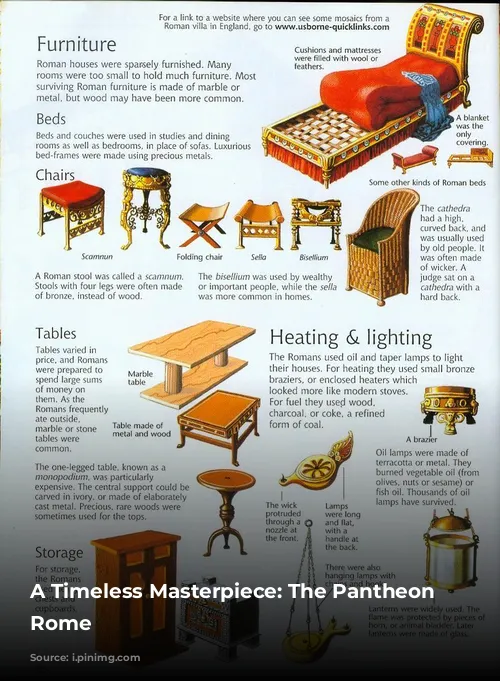The Pantheon, a majestic structure in the heart of Rome, stands as a testament to the ingenuity of Roman architecture. Originally built as a temple dedicated to the seven deities of the seven planets, it has served as a Christian church since the 7th century. This remarkable building boasts the distinction of being the best-preserved Roman structure, with its original roof intact, and is the oldest major building in the world still in continuous use. The Pantheon’s history is a fascinating journey through time, reflecting the evolution of Roman society and the enduring influence of its architectural brilliance.
A Temple Transformed: From Roman Gods to Christian Saints
The Pantheon’s story begins with the Roman Empire, during the reign of Marcus Vipsanius Agrippa. The inscription on its portico proudly declares, “Marcus Agrippa, son of Lucius, consul for the third time, built this.” The original Pantheon, constructed around 27-25 BC, was a grand complex, complete with adjoining baths and water gardens. Sadly, fire ravaged the structure in AD 80. It was Emperor Hadrian, a ruler known for his love of Greek culture and his cosmopolitan outlook, who oversaw the complete reconstruction of the Pantheon around 125 AD. The text of the original inscription was preserved on the new facade, reflecting Hadrian’s desire to blend tradition with innovation. Throughout its history, the Pantheon has undergone further repairs and restorations, ensuring its continued survival.
A Sanctuary Saved: From Spoilation to Sacred Ground
In 609, the Byzantine Emperor Phocas bestowed the Pantheon upon Pope Boniface IV, marking a significant turning point in the building’s destiny. The Pope reconsecrated the structure as a Christian church, dedicating it to Mary and all the Martyr Saints. This act of consecration proved to be a pivotal moment, preserving the Pantheon from the fate of many ancient Roman buildings that fell victim to neglect and plunder during the early Middle Ages. While the external sculptures that adorned the pediment above Agrippa’s inscription were lost, the marble interior and the magnificent bronze doors have miraculously survived, albeit after several restorations.
A Legacy of Bronze: From Cannon to Baldachin
The Pantheon’s story is not without its controversies. During the reign of Pope Urban VIII, the bronze ceiling of the Pantheon’s portico was melted down, a decision that sparked widespread criticism. The bronze was primarily used to create cannon for the defense of Castel Sant’Angelo, with a smaller portion going to the Apostolic Chamber for various projects. The debate surrounding the use of this valuable material persists to this day, with some claiming that the bronze was also used by Bernini in crafting the baldachin over St. Peter’s Basilica. However, Pope Urban VIII’s accounts suggest that the majority of the bronze was utilized for the cannon, while the bronze for the baldachin came from Venice. This controversial act gave rise to the famous Latin proverb, “Quod non fecerunt barbari, fecerunt Barberini” (“What the barbarians did not do, the Barberinis [family name of Urban VIII] did”).
A Place of Rest: From Kings to Artists
Since the Renaissance, the Pantheon has served as a final resting place for some of history’s most notable figures. Among those buried within its walls are the renowned painters Raphael and Annibale Caracci, the architect Baldassare Peruzzi, and two Kings of Italy: Vittorio Emanuele II and Umberto I, along with Vittorio Emanuele’s Queen, Margherita. The 15th century saw the Pantheon adorned with paintings, with the most famous being Melozzo da Forlì’s “Annunciation.”
A Legacy of Loyalty: The Vigil of Monarchists
Despite Italy’s transition to a republic in 1946, members of Italian monarchist organizations continue to keep a vigil over the royal tombs within the Pantheon. This practice has occasionally sparked protests from republicans, but the Catholic authorities have allowed it to continue. The Italian Ministry of Cultural Heritage is responsible for the Pantheon’s security and maintenance, while the building remains an active church, hosting Masses, particularly for weddings.
Architectural Marvel: A Dome for the Ages
The Pantheon’s architectural brilliance is evident in its unique circular design. A portico of three ranks of colossal granite Corinthian columns (eight in the first rank and two groups of four behind) supports a pediment that opens into the rotunda. Inside, a coffered concrete dome, the largest surviving from antiquity, crowns the space. This dome, with its central opening, the Great Eye, allows for the passage of natural light, creating a breathtaking spectacle. The dome’s weight is cleverly distributed through a ring of voussoirs, effectively transferring the load to the oculus.
Celestial Design: A Symphony of Light and Form
The Pantheon’s interior is a testament to the Romans’ mastery of engineering and their reverence for the cosmos. The height to the oculus and the diameter of the interior circle are identical (43 meters), creating a perfect cube that could theoretically encompass a sphere of the same diameter. This precise design, along with the dome’s coffered panels, which once contained bronze star ornaments, evokes a sense of celestial order. The Great Eye, the source of all light, symbolizes the sun, while the coffering, beyond its decorative purpose, reduced the dome’s weight, as did the absence of an apex due to the oculus.
A Legacy of Influence: From Rome to the World
The Pantheon’s enduring influence on architecture is undeniable. Its portico-and-dome structure has served as inspiration for countless buildings throughout Europe and America, from city halls and universities to public libraries. Notable examples include Thomas Jefferson’s Rotunda at the University of Virginia, Low Library at Columbia University, and the State Library of Victoria in Melbourne, Australia. Despite the passage of time and the removal of some of its original marble, the Pantheon’s majestic presence continues to captivate and inspire.
